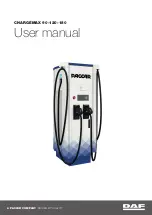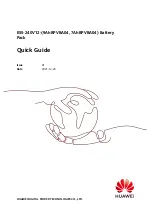
13
2.4.2 Battery Related Alarms
Over discharged Battery
<Urgent> the battery is still under 1.9 V/C after 30 seconds of charge and indicates
a faulty battery that needs investigation.
Deeply Discharge Battery
<Non-urgent> the battery initially is under 1.9 V/C but recovers within 30 seconds
of the charge cycle start, this alarm normally comes up when a battery is unplugged from the lift truck and
immediately plugged into the Charger.
Sulphated Battery
<Urgent> the battery fails to complete a de-sulphation profile applied by the Charger
correctly and generally means that the battery requires attention.
Incorrect Battery
<Urgent> the battery is inappropriate for the configuration of the charger and cannot be
charged without reconfiguring the charger to suit the battery.
Bulk Charge Timeout
<Urgent> the battery has exceeded the maximum time allowed for the initial constant
current bulk charge phase. Could indicate a faulty battery or the charger configuration is not correct for the size
of battery to be charged. May need additional Power Modules added to the Charger.
Finishing Charge Timeout
<Non-urgent> the battery has exceeded the maximum time allowed for the
finishing part of the charge cycle. Generally not a problem and indicates the battery did not quite perform as
expected. Not uncommon with new batteries that are still cycling up to full capacity (allow 10 cycles) however if
the alarm is a regular occurrence it needs investigation and possible adjustment of the charger or service of the
battery.
Battery Disconnected
<Urgent> the battery has been unplugged before charge cycle has complete. This can
damage the battery connector and increase risks of battery explosions as sparks around batteries at their top of
charge whilst gassing can be very dangerous. If the battery needs to be disconnected mid cycle, the toggle
switch must be first set to
STOP
. This will stop the charge and log a partial cycle in the charge log but allows
safe disconnection of the battery.
Reversed Battery
<Urgent> a battery with it’s plus and minus cables reversed has been connected to the
charger. Generally this will also cause an output fuse alarm and the need to replace the chargers DC output
fuse(s). Such a situation is not covered by warranty as new batteries should always first be checked for correct
polarity BEFORE plugging onto the lift truck or a charger.
Minimum dV/dt
<Non-Urgent> details the change in battery voltage over time. The alarm occurs when the
change in voltage exceeds the value set in the profile settings. This alarm also indicates the termination of a
successful charge.
Maximum Cell Voltage
<Non-Urgent> occurs when the voltage per cell exceeds the value set in the profile
settings. Typically 2.7 V/C for lead acid batteries.
Batt Over Temp – Start
<Urgent> occurs when the battery temperature measured before a charge profile
starts exceeds the value set in the controller settings. This alarm will not allow the charge profile to continue.
Batt Over Temp
–
Charge
<Non-Urgent> occurs when the battery temperature measured during a charge
profile exceeds the value set in the controller settings. This alarm will allow the charge profile to complete.
+dI/dt
<Urgent> occurs when the measured current in the constant voltage stage is rising instead of falling.
This alarm will terminate the charge profile.
Minimum Current
<Non-Urgent> occurs when using an IU profile and the current in the constant voltage
stage falls below the value set in the profile settings. This alarm will not stop a profile and is considered normal
for some types of batteries.
EQ/Refresh Timeout
<Non-Urgent> occurs when the time in a given stage of the equalize profile exceeds
the value set for that stage of the profile. This alarm will terminate the equalize charge but is not considered an
urgent alarm














































